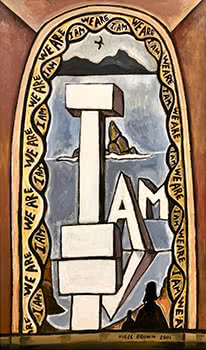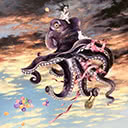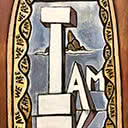Gray Sea I AM,
149 x 89 cm
est. $12,000 - 18,000
This is a late work in the I AM series of paintings. It was completed in the same year that the the artist left Auckland to settle in Cosy Nook, Southland after a couple of years as absentee owner. Prominent beyond the letters is Shark Tooth Rock and Foveaux Strait with a view to Rakiura. This was the view the artist and his wife lived with from their house in this remote area. The work mixes modernism with pictorialism in a challenging way. Even the individual I AM is bordered with a lace curtain chorus of WE ARE. This work probably suggested the title of the artist's fourth touring exhibition I AM/WE ARE in which Gray Sea I AM featured.
Born in Invercargill in 1949, Brown grew up in Tauranga and was fortunate to have the established artist Fred Graham as an art teacher at Tauranga Boys' College. Between 1968 and 1971 he attended Elam School of Art, gaining valuable wisdom and inspiration from teachers Robert Ellis, Pat Hanly, Colin McCahon, Garth Tapper and Greer Twiss. Brown first began exhibiting in 1972 and his highly praised Lemon Tree series (1977) helped to consolidate his position in the art scene.
In 1981, he was awarded a QEII Arts Council Grant for travel to the United States, the United Kingdom and Western Europe. On his return, the impact of the Springbok tour protests, as well as a period living with fellow neo-expressionist artist Philip Clairmont that same year, had a lasting impression on Brown. A founding member of the pressure group VAANA (Visual Artists Against Nuclear Arms) in 1984, Brown's paintings and prints of this period tackled relevant issues not only on nuclear weaponry but also on feminism and the peace movement. This culminated in his 1985 exhibition Living in the Bomb Age, at the Dunedin Public Art Gallery.
Brown's practice examines his direct and personal articulation of the realities of the human condition. He is profoundly aware of the relationship between human beings and their environment. Symbolism such as the fern, black singlet, dog and driveway, James K. Baxter and Captain Cook, all reflect his experience, his observations and his beliefs. He has woven these into a complex web over a period of more than 40 years.
In his early work he combined a tension and personal narrative centred on social issues in New Zealand topography. His later work included the socio-political world of the distinctly New South Pacific, while in his current practice, he continues to emphasise his vision of a New Zealand identity.
Brown has also undertaken two significant stained glass window designs - St Mary's Catholic Church, Auckland (1991) and Holy Trinity Cathedral, Parnell (1998). In 1998 he travelled to Antarctica as part of the inaugural 'Artist to Antarctica' programme.
In the 2004 New Year Honours, Brown was appointed an Officer of the New Zealand Order of Merit, for services to painting and printmaking and in 2005 Brown was awarded a three-week residency in Russia hosted by the New Zealand ambassador in Moscow.





